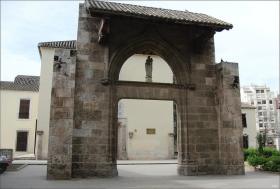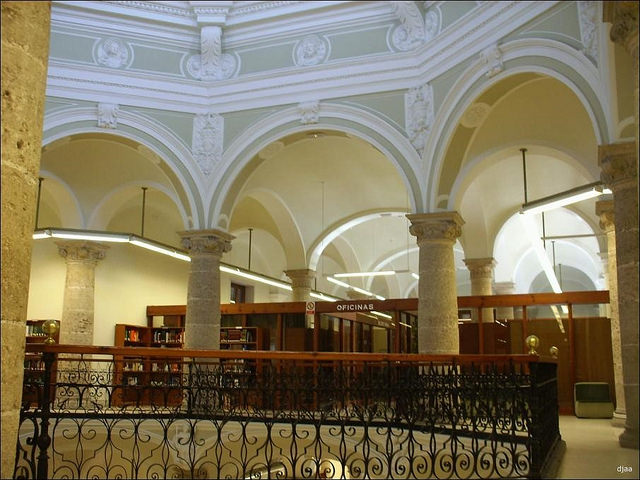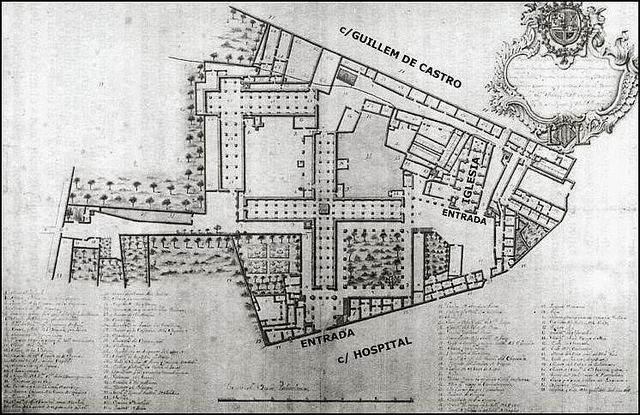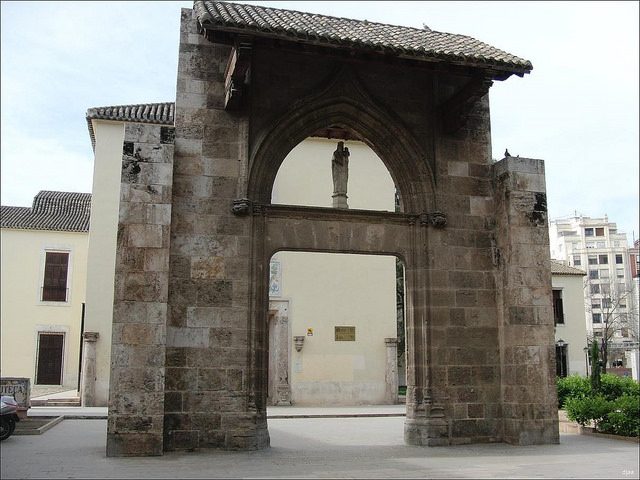
The Valencia General Hospital was born in 1512 following an arbitration ruling issued by king Ferdinand the Catholic, who ordered the unification of all the hospitals in the city of Valencia in one. The hospital was adjusted fairly accurately to the principles that had to govern these institutions, as Lluís Vives required at the beginning of the sixteenth century: “I call hospitals those institutions where patients are kept and cured, where a certain number of needs are sustained; where children are educated; where nobody’s children are raised; where the crazy people are closed and the blind ones spend their lives. Councilors of the city shall know that all these cures are their responsibility”.
The unification process, which began in the last quarter of the fifteenth century and culminated in 1512, was, fundamentally, carried out by the municipal government and the councilors of the Innocents Hospital. It must be borne in mind that both institutions were governed, after all, by the same people, that is, the urban oligarchy, made up of “citizens”, who politically and economically controlled the city. This fact meant that the new institution would be ruled by this group, through the administrators, the deputies and the key-bearer of the Hospital. However, despite the fact that the hospital unification was carried out by the municipal agreement to gather all the hospitals existing in the city limits in one, the new institution had a management, both administrative and economic, independent of the Council. In addition, until the end of the eighteenth century it was, as was also the case in the general hospitals of Zaragoza and Barcelona, an institution that was virtually autonomous of the royal power and of the Church.
The unified hospitals in 1512 were: the Innocents (founded in 1409 and destined for the assistance of mental patients), Santa Llúcia, popularly known as the Queen’s Hospital (founded during the thirteenth century and dependent on the municipality), En Clapers (erected in 1311 from a testamentary disposition of a citizen) and Sant Llàtzer (lazaret erected around 1240). In the city there were four more centres ‒ the Pobres Sacerdots, San Antonio, En Conill and En Bou (this last one only for fishermen) ‒, of small dimensions and with a restricted attendance; none of these hospitals joined the unification. After completing this process, the city of Valencia in 1512 went from having a medieval care system to having a fully modern one: the care was almost exclusively focused on the new General Hospital, which had been founded, as stated in the arbitral award, to accommodate all kinds of patients: “that from now on, there will be no more particular hospitalities, it will be a General Hospital”. In addition to this general character it had to be the only institution in the city of Valencia that could provide medical care: “in the said General Hospital, and not elsewhere in the city and its suburbs, there is hospitality for poor people”. This centre was intended, like all care institutions of this period, to the reception of “poor people”, that is to say, to the maintenance and care, of the body and soul, of the lower classes of society. Also, when incorporating the Innocents Hospital, it inherited the mission of freeing families from the burden and the danger posed by a mentally ill family member, alleviating society and emptying the streets from lunatic wanderers, trying to help these destitute and disadvantaged people and, when possible, cure them. It must be borne in mind that in the sixteenth century the separation process, from the medieval hospital, of two different institutions began: the hospital sensu stricto, intended to assist patients and to pick up orphans, and shelters or asylums for poor people. However, both problems were, to a certain extent, closely linked to the fact that both were public affairs of which urban authorities were in charge of, not in theory but in practice. This at a time when the modern state was under construction and had not yet assumed all its future competencies. Anyway, the passage of all these small centres, mostly inoperative, to a General Hospital led to a profound restructuring of the welfare system, which largely stayed until the nineteenth century, during which time the Hospital was radically transformed from the welfare structure to the form of government, as well as the medical ideas on which its operation is based on.
The government of the institution was in the hands of four administrators, who were elected every year. It was a canon from the cathedral of Valencia, two city councilors (the jury heads for the gentlemen and the citizens) and one of the ten members of the Brotherhood of the Innocents. The latter exercised a strong control of everything that happened to him, in the General Hospital, since, although they did not perform specific functions, one of them was the administrator and the other, the key-bearer, annual position that exerted management functions, which directly controlled all the economic management and that had the employees under their command.

The sixteenth century hospital was structured in a series of sections or rooms, were patients were cared for according to their disease. During the sixteenth century, these rooms were: the one for “fevers”, the one for “syphilis” (also known as morbo gallico or French disease) and the one for the “wounded”. Besides, three rooms from the former unified hospitals were kept: the “lunatics” room, from the former Innocents Hospital; the “foundling” room (abandoned babies), which was the most important section of the Queen’s Hospital, and the “lepers” room, from the former lazaret. The latter was the only building that was not evacuated, since leprosy was considered a contagious disease, and it was believed convenient to keep patients in the old lazaret, located on the outskirts of the city, although the Sant Llàtzer Hospital ceased to exist as such and eventually became a section of the General Hospital. The rooms for fevers, syphilis and wounded were in turn divided into men and women rooms. The convalescent room, which already functioned as an annex to the fever room some years earlier, was added to these sections in 1589.
The General Hospital was located on the site of the old Innocents Hospital, in the western part of the city, next to the wall. In 1492, a “cross-shaped” work began to expand the hospitality capacity of the Innocents Hospital. As its name implies, it was a building with a cross floorplan, in accordance with the principles of hospital architecture of the time, which was to be attached to the old asylum. These works were interrupted before their completion as a result of the economic problems of this institution, and the same process of hospital unification initiated in these years. Once the unification was agreed and for a three-year period, the necessary works were completed to finish the transept and prepare it as a General Hospital. The building consisted of two transepts (one of which was inconclusive, with only two arms), which touched each other by the ends in the form of a double x. In the transepts there were fever, morbo gallico and wounded sickrooms; men occupied the high part, and women, the low one. The rest of the rooms were located around the two transepts. The demented room was kept in the medieval building, which was located between the church and the city wall. Among all these rooms were a series of orchards and patios for uses as diverse as the cultivation of vegetables or the cemetery.

as well as the multiple facilities.
At the end of the sixteenth century, the hospital had about 279 beds of different types, some of which were occupied by more than one patient. In addition, when many patients were hospitalised and the beds were not enough, it was frequent to allocate mattresses on the floor in several infirmaries. Mental patients, however, were in separate units, separated, with no communication between men and women. Likewise, the furious did not coexist with the peaceful ones. The former were shut in small rooms or cells, called “cages”. There were several of them and they were located next to each other, along a corridor, separated by limestone walls. Each cell was independent and accessed through an iron bars door that was locked with a padlock. The peaceful ones had freedom of movement within the Hospital and they even collaborated in the financing of the centre, since they could leave the city to ask for alms and in some holidays.
Regarding the kind of patients that were cared for in this institution, it is necessary to say, as we have already indicated, that they mostly belonged to the lower strata of society. The “typical patient” was a sick individual who either made a living out of his/her job but the illness had disabled him/her and, therefore, he/she was left without resources, or, to a lesser extent, lived on charity. For example, at the late sixteenth and early seventeenth centuries, a large number of French emigrants, highly-skilled workers, who had no family environment capable of caring for them if they became ill and that, in addition, were left without money having to leave the job. Therefore, the only solution left to survive or to try to heal themselves was to be admitted in the Hospital. It should be noted that, on the other hand, local craftsmanship, in addition to the family, had a trade union charity. This way, the geographic origin of patients, in the same way that their income, was very heterogeneous and varied according to the different demographic and economic conjunctures. In general, it can be said that there was a general tendency to increase annual income, although they experienced large variations, since this was directly related to temporary causes such as epidemics, the king visiting the city or periods of famine in nearby areas. Those years, a total of 4,000 patients could be hospitalised, when the usual were around 1,000 per year. On the other hand, all the patients, except lunatics and prostitutes of the brothel, went voluntarily to the Hospital, and there they were taken care of for free. In this case, mental patients were once again an exception, since only their extreme and manifest indigence and that of their relatives could exonerate them from paying for their stay.

The Hospital cared for patients with a high number of employees, almost half of which performed care services. The service staff (cooks, bakers, hen farmers, etc.) represented one third of them. The ecclesiastic staff was very scarce until 1585, since there was only one vicar and one sacristan. But, from that date on, after the establishment of four chaplaincies from two testamentary legacies of two noble women of the city, the hospital had nine priests, a vicar, four confessors and four non-confessor priests. Finally, the bureaucracy was commissioned by the employees dedicated to the administration and management tasks were responsible for bureaucracy. Among the welfare staff there were both crystallised professions (doctors, surgeons and the apothecary), as mere occupations carried out by people without any kind of preparation (nurses, assistants, etc.). This group was heavily hierarchised, since the doctor was in the lead, visited the patients twice a day and gave the necessary instructions to the surgeon, the caregiver, the apothecary, who prepared the medications, and the “fathers” and “mothers” or room chiefs, who were in charge of different infirmaries. In addition, there was a Bachelor (vellant), who was a medical student with, in some way, the duties of a doctor on call, since he was responsible for examining sick patients when they arrived and to send them to the corresponding room, he consulted daily with the doctors and was in charge of controlling the recipes that were prepared in the apothecary. All healthcare personnel, with the exception of doctors, had the obligation to reside with their families in the offices of the institution. Logically, wages were very diverse and ranged strongly over time. The best paid were surgeons and the apothecary, while the lowest salaries were paid to room servants. All the personnel was paid, apart from a money wage, the so-called rations, which were quantities in kind of various products, particularly food. The amount and type of ration varied according to the category and responsibility of the position.
The diet of the patients was based, basically and in accordance with the Valencian food system of the moment, in wheat bread, lamb and chicken, eggs and wine, as well as fish during religious abstinences and vegetables grown in the orchard. The foods were mainly consumed cooked and roasted, as well as in a large number of broths – very important for the patients according to the dietary norms of the time – and cooked fruit. Patients, depending on their condition, received medical or surgical treatment. The Hospital had an apothecary that complied with the standards of the School of Apothecaries of the city, as well as the treaties on medical knowledge of the time. All medications in the pharmacy had precise therapeutic indications and, to a large extent, they were effective. Crazy people, considered sick, also benefited from this treatment. In addition, different surgical operations were carried out, both for those hospitalised as well as for those who came to receive this treatment from the surgeons of the institution. Finally, during spring and autumn, mercury ointments were administered as a treatment for French evil.
The Hospital had a close relationship with the General Study from the beginning. On the one hand, most of the doctors of the institution were simultaneously professors and, on the other hand, there is explicit mention of the use of the Hospital for the teaching of medicine. This aspect can be confirmed through the presence of the Bachelor, who served patients in return for the medical practice they obtained, and the existence, at least since 1586, in the hospital enclosure of a “house of anatomies”, facility where the autopsies were practiced, which were used by the general Study professors.
The Hospital had a very long life (in fact, at present it is still in operation in another location). The different buildings and spaces ‒ innumerable and diverse, given the great activity that was carried out in them in order to meet and to take care of all the needs of the patients, as to manage the institution ‒ were adapted to the demands, the medical ideas and the events, sometimes tragic, of every moment. In the space that remained empty as a result of the demolition of the wall and the main building, the Faculty of Medicine was inaugurated in 1885, of which there are barely any features on the front door, until the new faculty was transferred to Blasco Ibáñez. Today, the eminent rooms of the Public Library of Valencia take advantage of the magnificence of the imposing hospitable building built in the sixteenth century. The second transept, started in 1586, was less fortunate, only two arms were built and there is nothing left of it. Unfortunately, only the 1512 transept remains in place, the rest ‒ including the 1586 transept and the Innocents Hospital of the fifteenth century ‒ was demolished at the beginning of the 1960s; it is one of the few things that remain intact, after laziness and spoliation, of that architectural ensemble, an inseparable part of the history of the city for centuries.
Marialuz López Terrada (INGENIO, CSIC-UPV)
Carmel Ferragud (“López Piñero” Institute of History of Medicine and Science)
Personatges i espais de ciència (‘Science characters and spaces’) is a project of the Unit of Scientific Culture and Innovation of the University of Valencia, with the collaboration of the “López Piñero” Institute of History of Medicine and Science and with the support of the Spanish Foundation for Science and Technology and of the Ministry of Economy, Industry and Competitiveness.

.jpg)











